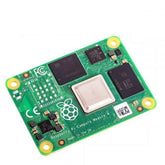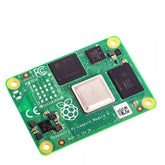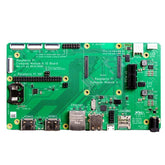The New Formlabs’ 3D Printer is Built on the Compute Module 4
Summary
Raspberry Pi’s Compute Module 4 has moved beyond hobbyist applications, powering Formlabs’ latest industrial-grade 3D printer, the Form 4. By integrating a proven, off-the-shelf system-on-module, Formlabs streamlined development, boosted performance and ensured long-term supply stability—demonstrating how Raspberry Pi products can meet rigorous commercial and industrial demands.
Why Formlabs' Chose Compute Module 4

Formlabs was working on their new 3D printer, the Form 4, and they ran into some pretty demanding tech needs. They needed something powerful enough to run two high-res displays for the user interface and also handle a camera at the same time for those cool timelapse videos.
On top of that, they wanted solid security features, like being able to turn off Wi-Fi completely in places where things need to stay locked down.
And as if that wasn’t enough, they had to make sure their setup wouldn’t get messed up by all the global chip shortages. So yeah, they had a lot to juggle.
After checking out a bunch of options, they landed on the Raspberry Pi Compute Module 4. It had the right balance of power, graphics support, and memory.
Plus, it’s designed in a way that makes it easy to plug into a custom board, which was perfect for their needs. Basically, it ticked all the boxes without overcomplicating things.
Design and Integration Details
Carrier Board Customization: Formlabs designed a motherboard with mezzanine connectors to host the Compute Module 4. This approach provided clean, high-speed board-to-board signals while allowing the carrier board to handle real-time tasks via an NXP i.MX RT1050 microcontroller.
Storage Configuration: A 32 GB eMMC chip on the carrier board retains system data independently of the module, simplifying module replacement without data loss.
Security Controls: A hardware jumper lets integrators disable Wi-Fi, and the option to deploy a non-wireless CM4 variant addresses strict security requirements for government and military customers
Peripheral Allocation:
- MIPI-CSI connects to a 5 MP camera for timelapse videos of print progress.
- USB OTG supports external accessories or direct printer-to-computer links.
- Ethernet and Wi-Fi provide network connectivity to Formlabs’ desktop and cloud applications.
This modular design let Formlabs focus on printer mechanics and resin chemistry, while offloading general-purpose computing to the readily available Compute Module 4.
Industrial-Grade Performance and Reliability
Compute Module 4’s combination of a quad-core Arm Cortex-A72 processor, VideoCore VI GPU and up to 8 GB of RAM (in other variants) delivers the throughput needed for high-resolution graphics, camera processing and multiple concurrent services. For Form 4 users, this means:
- Responsive User Interface: Touchscreen and graphical controls feel as seamless as a smartphone, reducing operator training time.
- Consistent Print Quality: Precise control loops for motor movements and temperature regulation run without bottlenecks.
- Automated Monitoring: High-quality timelapse videos and real-time logging help diagnose issues and optimize print parameters.
Extensive field testing across tens of thousands of units revealed an impressively low module failure rate, reaffirming Raspberry Pi’s reputation for reliability in demanding environments.
Faster Time-to-Market and Cost Savings
Adopting Raspberry Pi Compute Module 4 as a standard SOM saved Formlabs both time and money:
Reduced Engineering Overhead: Eliminating the need to design and certify a custom SOM cut development cycles and certification efforts.
Lower Bill-of-Materials Costs: The Compute Module 4 delivered superior performance at roughly a $30 lower BOM cost than the previous, fully custom SOM.
Supply Stability: During the global silicon shortage, Raspberry Pi maintained manufacturing capacity and worked closely with Formlabs to align allocations with demand forecasts.
These efficiencies allowed Formlabs to reallocate resources toward enhancing resin technologies and user-experience features rather than reinventing core computing hardware.
A Blueprint for Commercial Integration

Formlabs’ success illustrates a broader lesson for technology integrators: off-the-shelf modules like Compute Module 4 can serve as the backbone for sophisticated products, from medical devices to industrial automation systems. Key takeaways include:
Plug-and-Play Development: Leveraging existing Linux kernel support and pre-configured BSP layers accelerates initial bring-up and reduces software risk.
Scalable Customization: Carrier boards can adapt the module’s interfaces to unique product requirements without redesigning the compute engine.
Long-Term Support: A defined production roadmap—combined with broad community adoption—ensures modules remain available and secure over multiple product generations.
Ecosystem Benefits: Access to compatible HATs, camera modules and software libraries expands functionality without added development complexity.
By following this blueprint, businesses can focus engineering efforts on domain-specific innovations while relying on Raspberry Pi’s proven compute platform for core system performance.
Conclusion
Compute Module 4’s performance, flexibility and supply-chain resilience enabled Formlabs to deliver the Form 4 printer faster, at lower cost and with a polished user experience. For companies seeking to integrate advanced computing into their products—whether in 3D printing, robotics, smart sensors or beyond—the Raspberry Pi Compute Module series offers a compelling blend of engineering simplicity and commercial reliability.










